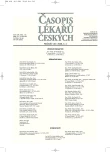EBV Quantification in Children Undergoing Allogeneic Hematopoietic Stem Cell Transplantation
Authors:
P. Hubáček 1,2; O. Cinek 2; M. Kulich 3; M. Zajac 4; P. Keslová 1; R. Formánková 1; J. Starý 1; P. Sedláček 1
Authors‘ workplace:
Klinika dětské hematologie a onkologie 2. LF UK a FNM, Praha
1; Pediatrická klinika 2. LF UK a FNM, Praha
2; Katedra pravděpodobnosti a matematické statistiky, Matematicko-fyzikální fakulta UK, Praha
3; Ústav lékařské mikrobiologie 2. LF UK a FNM, Praha
4
Published in:
Čas. Lék. čes. 2006; 145: 301-306
Category:
Original Article
Overview
Background.
Patients undergoing allogeneic hematopoietic stem cell transplantation (AHSCT) are endangered by developing Epstein-Barr virus-related post-transplant lymfoprolipherative disease (EBV-LPD). The aims of the study were to retrospectively characterise the viral loads in four patients who died of this complication, and to test possible risk factors for EBV reactivation in a prospectively observed cohort of children after AHSCT.
Methods and Results.
Serial DNA samples extracted from whole blood from four patients who died of post-transplant EBV-LPD in year 2000 were retrospectively analysed for EBV load using quantitative real-time PCR. First detection of EBV activation preceded death by 24-91 days. All four patients exceeded a viral load of one million EBV copies per 100,000 human genome equivalents. A cohort of 72 children undergoing AHSCT between 2001-2004 was prospectively followed-on using the same quantification method from regularly obtained samples of whole blood, and clinical and laboratory data were recorded on a weekly basis, totalling at 3,896 person-weeks of observation. Approximately one half of the cohort experienced at least one episode of EBV reactivation during the first 100 days after AHSCT, four of the episodes being accompanied with viral loads higher than our provisional threshold of 10,000 copies per 100,000 human genome equivalents. Three of the four patients developed EBV-LPD and were successfully treated by intravenous administration of anti-CD20 antibody. Testing of possible clinical and laboratory predictors of EBV reactivation did not reveal any clinically useful association.
Conclusions.
The cornerstone of predicting EBV-LPD in AHSCT is a regular monitoring of EBV viral load using quantitative methods. Using this strategy with a threshold of 10,000 EBV copies per 100,000 human genome equivalents was proved to be effective, as shown by no death of EBV for the study period, compared to four cases in the year before the quantitative monitoring.
Key words:
EBV, lymphoproliferative disease, allogeneic haematopoietic stem cell transplantation, PCR.
Labels
Addictology Allergology and clinical immunology Angiology Audiology Clinical biochemistry Dermatology & STDs Paediatric gastroenterology Paediatric surgery Paediatric cardiology Paediatric neurology Paediatric ENT Paediatric psychiatry Paediatric rheumatology Diabetology Pharmacy Vascular surgery Pain management Dental HygienistArticle was published in
Journal of Czech Physicians

Most read in this issue
- Purkynje Fibers of the Heart Conduction System – History and the Present Time
- Larva migrans cutanea
- Pulmonary Endarterectomy – The Surgical Treatment of Chronic Thromboembolic Pulmonary Hypertension
- Long-lasting Cardiostimulation in the Treatment of Heart Failure
